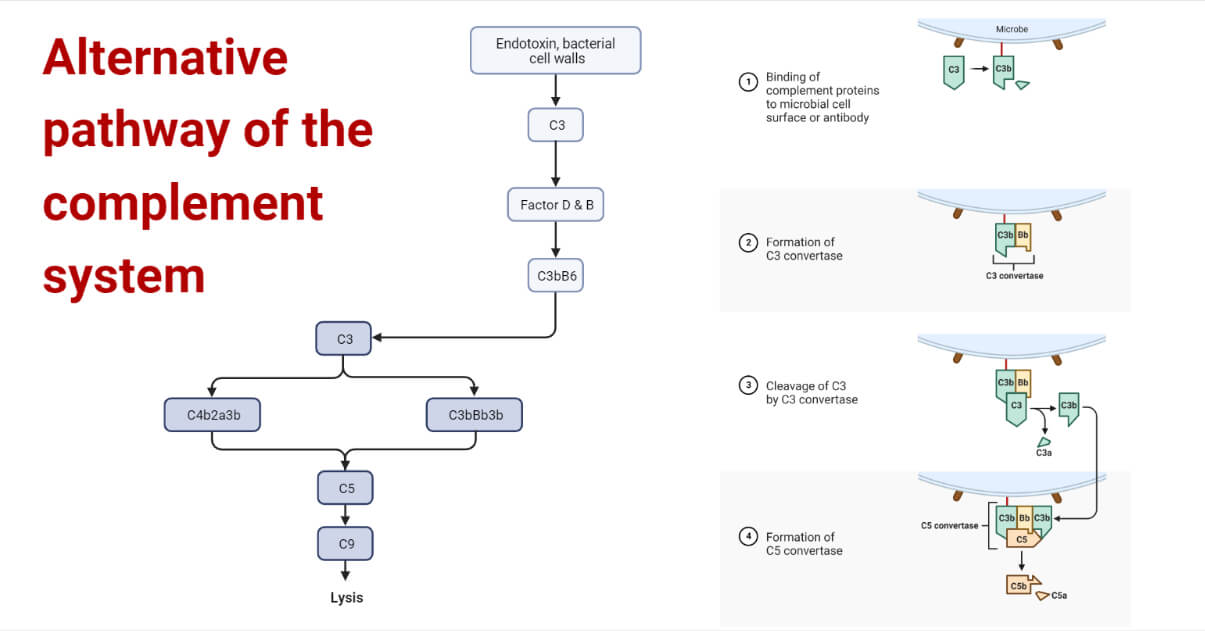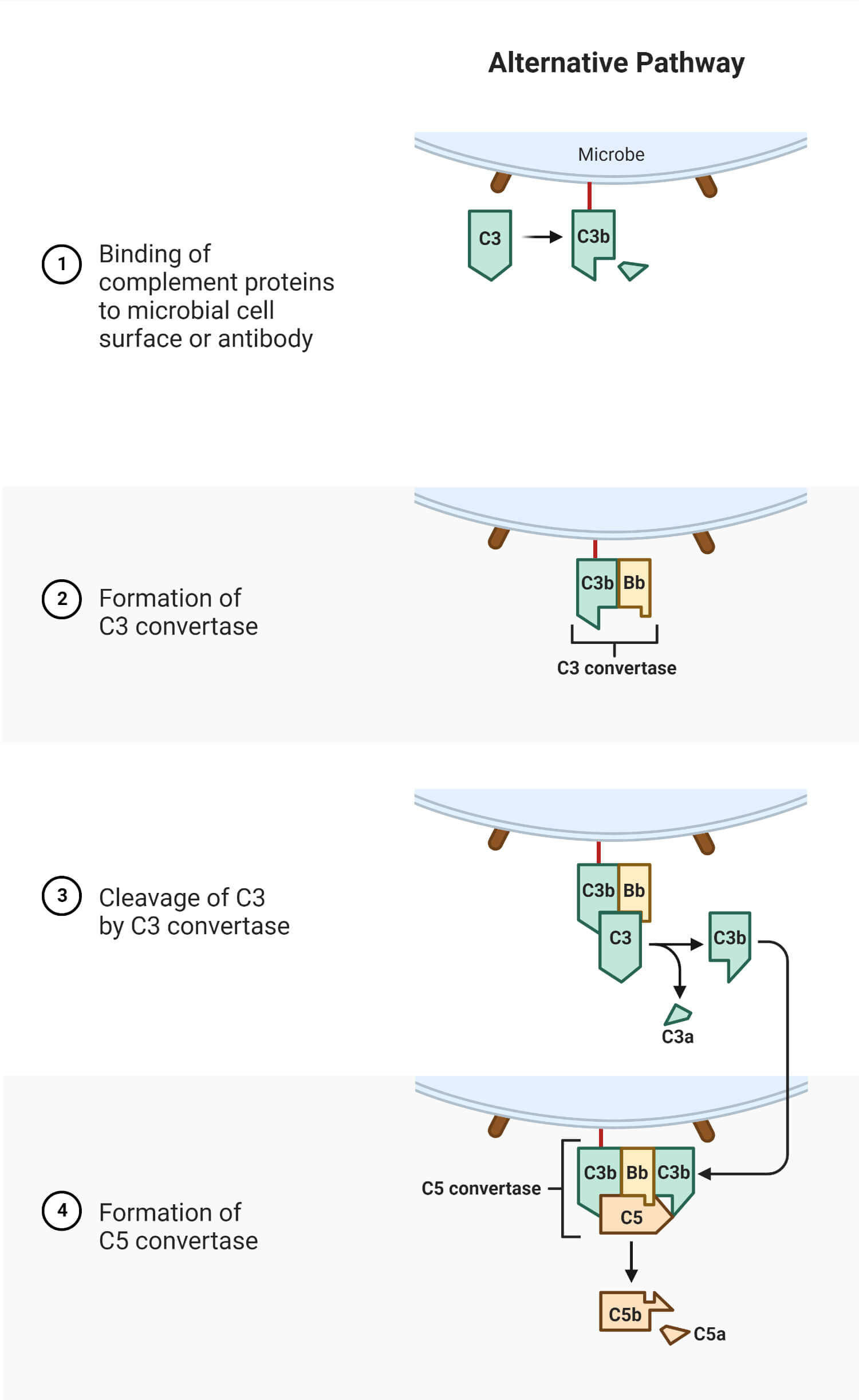The alternative pathway (AP) is dominant to the classical and lectin pathway during normal physiological conditions. This pathway is constantly activated at a low level in which C3 gets hydrolyzed to C3b. If foreign biological and artificial surfaces like carbohydrates, lipids, proteins, gas bubbles, etc., are encountered, this pathway gets automatically triggered. The continuous activation of C3 is termed “tick over” which generates low levels of C3b and gets amplified if needed.

Interesting Science Videos
What is Alternative pathway of the complement system ?
The alternative pathway of the complement system is a cascade of enzymatic reactions which requires spontaneous hydrolysis of the internal C3 thioester bond. The hydrolyzed protein then binds to serum factor B.
Steps / Mechanism / Process of Alternative pathway of the complement system
The components of this pathway include:
C3, C5-C9
Factor B
Factor D
Factor P (properdin)
- Upon encountering foreign surfaces, the 3b protein binds directly to these surfaces and, unlike the classical pathway, does not require the formation of antigen-antibody complexes.
- The hydrolyzed thioester domain of C3 undergoes structural change exposing the binding site for Factor B. Mg2+ is the only ion required for functional activation of the alternative pathway that stabilizes the interaction between C3b and factor B.
- This C3(H2O) bound Factor B is cleaved by serine protease Factor D, forming C3(H2O)Bb, C3 convertase. C3 convertase in the alternative pathway is unique as it is made up of subunits C3b and Bb. This complex can now activate more C3 via a powerful amplification cycle; therefore, this pathway is also called “the amplification loop”.
- The convertase complex, in turn, cleaves C3 to C3a and C3b. The 3a fragment is released into the fluid phase.
- When a second C3b adds to it, the C5 convertase is synthesized.
- The membrane attack complex is formed following the same pathway as the classical pathway of the complement system. C5 convertase cleaves C5 into subunits C5a and C5b. C5b recruits C6, C7, C8, and C9 forming MAC that induces cell lysis.

Three distinct pathways to initiate alternative pathway has been discovered:
- The alternative tickover pathway
The above-mentioned pathway that constitutes spontaneous hydrolysis of C3 to C3(H2O) is termed the tickover pathway.
- The alternative properdin-activated pathway
The serum protein properdin promotes the synthesis of AP convertases. It is synthesized by monocytes, granulocytic cells, and T cells. The C3Bb complex has a half-life of only 90 seconds under physiological conditions but properdin, when gets associated with this complex, makes it more stable.
Besides maintaining the stability of convertases, properdin may also initiate an alternative pathway. Properdin, when bound to components of microbial membranes in the presence of Mg2+, can now bind C3b and factor B.
- The alternative protease-activated pathway
Proteases of blood coagulation pathways such as thrombin and plasmin could cleave C3 and C5, releasing C3a and C5a, respectively. This process can enhance the activation of complement cascades.
Regulators of the Alternative Pathway
As this pathway does not require any immune response and is activated independently upon encountering foreign particles, it must be rigorously controlled to prevent unwanted host cell attacks.
- Complement factor H (CFH): It is a soluble inhibitor of C3 convertase. It acts as a cofactor in the cleavage of C3b to iC3b. This factor is required to control physiologic, spontaneous hydrolysis of the C3 molecule under control.
CFH inhibits the formation of the C3 convertase by competing with factor B. It accelerates the dissociation of the C3bBb convertase complex. The deficiency of this factor leads to kidney abnormalities such as atypical hemolytic uremic syndrome (aHUS).
- Membrane cofactor protein (MCP), decay acceleration factor (DAF), and complement receptor 1 (CR1) are membrane inhibitors of C3 convertase. MCP and CR1 are cofactors for the inactivation of C3b and C4b that occurs via complement factor I (CFI).
CFI is a plasma protease that prevents the reassembly of C3 convertase by proteolytic inactivation of C3b to iC3b (inactive C3b).
- Complement factor H-related protein (CFHR), P-selectin and heme are activators of C3 convertase. CFHR has a control function by competing with CFH for binding to C3b.
Applications / Significance of Alternative pathway
- This pathway monitors pathogen invasion in normal physiological conditions.
- Infiltrating cells such as neutrophils bring in C3 and properdin that can initiate alternative pathways.
- Factor B is an acute phase protein and increases during inflammation.
- C5a and C3a are important mediators of inflammation.
- Cell lysis and inflammation are induced by MAC.
References
- The alternative complement pathway revisited – PubMed (nih.gov)
- Owen JA et al (2013). Kuby Immunology. 7th edition. W.H. Freeman Company. New York
- Complement System | British Society for Immunology
- Properdin and complement activation: a fresh perspective – PubMed (nih.gov)
- Alternative Pathway | Sino Biological
